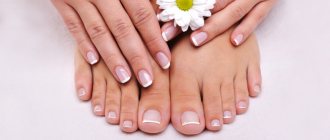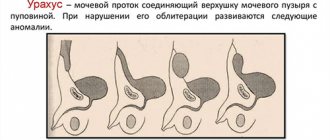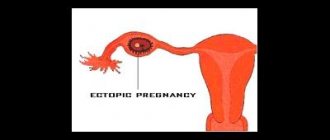Causes of synechiae
- Genitourinary infections - vulvovaginitis, vulvitis, etc. Infection is possible in the maternity hospital or at home, when swimming in stagnant natural bodies of water.
- Violation of intimate hygiene rules. Both a lack of hygiene and its excess are harmful.
- Allergy in a child. A reaction can occur to food (from the diet of a girl or a nursing mother), components of care products, washing powder, etc.
- Difficulties during pregnancy - intrauterine infections, severe toxicosis. If a mother had difficulties during pregnancy, her daughter increases the risk of developing synechiae.
- Genetics. The tendency to fusion of soft tissues can be transmitted from mother to daughters.
- Wearing tight synthetic underwear, which creates all the conditions for inflammation.
- Reduced estrogen levels. This is normal before puberty, but in some girls it causes synechiae.
- Dysbacteriosis. Pathogenic intestinal flora can provoke adhesions. Source: Z.K. Batyrova, E.V. Uvarova, L.S. Namazova-Baranova, N.Kh. Latypova, A.E. Donnikov Fusion of the labia minora in girls during early childhood: tactics of a pediatric gynecologist // Issues of modern pediatrics, 2012, vol. 11, no. 2, pp. 118-121
Diagnostic methods
If a gynecologist finds synechiae in a girl during an examination, he must assess how dangerous this condition is and whether the child has concomitant diseases that could cause it.
To identify the causes of synechiae, the following laboratory tests may be required:
- smear analysis;
- general blood and urine analysis;
- stool examination for dysbacteriosis;
- stool analysis for worm eggs and scrapings for enterobiasis;
- checking blood sugar levels.
Symptoms and signs of fusion of the labia majora and minora in a child
With complete adhesion:
- There are difficulties with urination. The child becomes very nervous when the urge arises, strains hard on the potty, cries, and refuses to go to the toilet.
- Stagnation of urine causes infections in the urethra, which are manifested by: rash;
- redness and peeling of the skin in the intimate area;
- secretions.
The mother can examine the girl herself. To do this, you need to separate the labia majora. With synechia, the small ones do not “come apart” and they are connected by a whitish-gray film, similar to a membrane. When trying to separate the labia minora, the child begins to cry - it hurts.
Why is phimosis dangerous?
With phimosis, inflammation of the foreskin and glans may occur - balanitis, balanoposthitis.
If the opening of the foreskin is very narrow, the glans penis may be pinched - paraphimosis.
Phimosis makes it difficult to urinate, resulting in increased pressure in the urinary tract, which, in turn, can lead to serious diseases such as pyelonephritis and ureterohydronephrosis (negatively affecting kidney function).
Constant straining when urinating increases pressure in the abdominal cavity, which can cause a hernia or prolapse of the rectum.
How to treat the disease?
If a girl has small (up to 5 mm) synechiae between the labia minora and labia majora, then this is not dangerous. The outflow of urine is not impaired, negative consequences are excluded. Therefore, in this case, you only need to show the child to a pediatric gynecologist once every six months. For synechia of the labia minora, conservative or surgical treatment may be prescribed. The doctor will give recommendations on proper hygiene and child care.
Conservative therapy is the use of ointments with estrogen in a course that is calculated individually (from 1 week to 2 months). As a result, the labia separate, and the ointment is gradually replaced with a baby cream recommended by the doctor.
If the case is advanced, surgery is needed. Synechiae are divided surgically under local anesthesia or general anesthesia. To prevent a relapse, they then make baths with herbs and use ointments.
Massage
This treatment is one of the auxiliary methods for treating synechiae. After applying the ointment, massage is performed. After waiting a minute or two until the gel-cream begins to be absorbed, begin massaging the glued labia. The movement in this case should be smooth, gentle, but a little oppressive.
If the seal is incomplete, try gently pressing your lips together, but don't overdo it. It is not recommended to make sudden movements, especially attempts to separate glued lips, as these movements can cause injury or psychological discomfort to the child.
The following home remedy worked well. Wipe the sore area with a cotton pad soaked in potato juice, trying to slightly stretch the labia in different directions. This procedure should be regular. Thus, in case of incomplete anastomosis, surgical separation can be avoided with the help of special massage.
Prevention in girls
Important! All newborn girls under 2 years of age must be shown to a pediatric gynecologist in order to identify synechiae as early as possible and avoid surgery. This is especially true for girls with allergies who are at risk.
Synechia of minora and labia majora in girls is prone to multiple relapses even after surgical treatment. The problem goes away completely only after the child reaches puberty. However, the risk of relapse can be reduced by following the basic rules of prevention - hygiene and daily routine. Source: Gayle O. Fischer Vulval disease in pre-pubertal girls // Australasian Journal of Dermatology. 2001, 42, 225-236
Prevention recommendations:
- Change diapers in a timely manner and give them up as soon as possible.
- Pay maximum attention to hygiene - gently wash the girl twice a day with warm water. There is no need to use soap and other cosmetics, because they wash out the microflora and dry out the mucous membranes of the vagina.
- Contact your doctor if your child complains of difficulty urinating.
- Use any creams or ointments for the intimate area only after consulting a doctor.
- Don't get carried away with bubble baths. If the child loves them very much and does not want to give them up completely, you can add them at the very end of the bath.
- A girl's underwear should be made of 100% cotton because it allows the skin to breathe and ventilate well. Make sure that the underwear does not rub or press anywhere, as this can lead to inflammation.
- Regularly show the girl to a pediatric gynecologist, even from the age of an infant, in order to promptly notice not only synechiae, but also other pathologies. Many mothers believe that little girls do not need this, but the doctors’ recommendation is clear: start visiting a gynecologist from preschool age.
- In most cases, the causes of synechiae are incorrect and/or incompletely treated infectious and viral diseases. Therefore, it is necessary to show the child to the doctor in a timely manner and follow all his recommendations.
- It is better to wash children's clothes separately from adult clothes.
- In the third trimester, the expectant mother must actively fight late toxicosis - high blood pressure, protein in the urine, edema. Such symptoms complicate childbirth and lead to pathologies in infants.
- Buy toilet paper, cosmetics and detergents without fragrances or artificial colors.
- As a preventive measure, use ointments with estrogen, but only for those girls who have previously had clumping of the labia. The duration of treatment and dosage are determined only by the doctor.
Sources:
- https://www.ncbi.nlm.nih.gov/pmc/articles/PMC4846402/ S. Bussen, A. Eckert, U. Schmidt, and M. Sütterlin Comparison of Conservative and Surgical Therapy Concepts for Synechia of the Labia in Pregnancy -Pubertal Girls
- Z.K. Batyrova, E.V. Uvarova, L.S. Namazova-Baranova, N.Kh. Latypova, A.E. Donnikov. Fusion of the labia minora in girls during early childhood: tactics of a pediatric gynecologist // Issues of modern pediatrics, 2012, vol. 11, no. 2, pp. 118-121.
- Gayle O. Fischer. Vulval disease in pre-pubertal girls // Australasian Journal of Dermatology. 2001, 42, pp. 225-236.
Preventive actions
Prevention of synechiae in girls includes the following measures:
- Adequate care. After defecation, the child is washed with a neutral agent, and the rest of the time with clean warm water. Moisture from the genitals is removed with a soft, clean towel without rubbing.
- Regular air baths. It is important to ensure frequent contact of intimate areas with air. It is enough to let the baby walk naked after each wash.
- Timely response to inflammation. If you notice diaper rash, peeling, rash or redness of the genital mucosa, you should consult a doctor.
- Eliminating allergens. If you are hypersensitive to food or chemical allergens, contact with them should be completely avoided.
Synechiae can form over several months or within a few days. In order to identify the problem in time, it is necessary to pay attention to the condition of the child’s genitals every day.
Necessary treatment
How to treat synechiae in girls? In 80% of cases, synechiae does not require treatment and goes away on its own. Russian doctors often insist on separating the labia, frightening parents with infections and urination problems. But synechiae does not increase the risk of developing inflammatory processes. On the contrary, they act as a mechanical barrier against any contamination.
In addition, mechanical separation often leads to relapses. The delicate tissues of the labia are damaged and then grow back together. In this way, it is impossible to eliminate the main cause of the formation of synechiae - hormonal. It should not be eliminated, since low estrogen levels are a common occurrence for a child who has not reached puberty.
The best solution is to monitor the condition of the child's genitals and intervene only when problems arise.
What to do if synechiae interferes with urination and contributes to the development of the inflammatory process? Synechiae of the vulva are eliminated by two methods:
- a surgical operation in which the sponges are separated mechanically;
- conservative therapy, involving the use of ointments and creams.
Pediatric gynecologists suggest starting not with mechanical separation of the labia, but with a more gentle method. The situation can be corrected with the help of ointments containing estrogen. Some people suggest applying a compress with ointment to the labia at night, others think that it is enough to lubricate only a thin strip of tissue between the girl’s lips. It depends on the degree of “sticking” of the lips. The procedure must be performed for at least five to seven days. Adhesions can be eliminated with the help of contratubex and ovestin creams. Contratubex has a milder effect, since it is a non-hormonal agent.
Hormonal ointments (for example, Ovestin) can be dangerous due to their side effects, so they should be used only under the supervision of a pediatric gynecologist and only for the period determined by the doctor. An increased level of estrogen as a result of the use of the ointment is indicated by swelling of the mammary glands and increased pigmentation of the vulvar mucosa.
What ointments and creams can be used in the treatment of synechiae:
- Ovestin;
- contratubex;
- traumeel C;
- malavit.
Malavit cream relieves dryness and irritation after hygiene procedures; it can be used after each wash. If the skin is very irritated, the cream may cause a slight tingling sensation due to the menthol content. There is no need to be afraid of this. After a couple of days, the affected tissues will recover and the tingling will disappear.
Ovestin should not be used more than once a day, and it can only be applied in a very thin layer. Usually this procedure is done at night. Two or three times a day, two creams can be applied to the synechiae area - contratubex and traumeel S. The diaper is put on only after the cream has had time to be absorbed. If a discrepancy does not occur within two weeks of treatment, you should take a break: give up Ovestin for 7-10 days, but continue to use Contratubex.
If the girl’s lips are strongly fused, and treatment with ointment does not produce results, we have to resort to mechanical separation. It should only be performed under local anesthesia. Synechiae are surgically separated using a grooved probe.
Do not trust those doctors who offer to separate the labia without anesthesia and with the help of fingers, because such rough intervention will be painful for the baby.
After the operation, you will need to carefully monitor hygiene - take baths, treat the labia with special oils, creams and ointments. In some girls, the labia grow back together.
If a child has concomitant diseases (allergies, dysbacteriosis, helminthiasis and others), they need to be eliminated. It would not be superfluous to introduce a hypoallergenic diet for the period of treatment and check the girl for the presence of parasites in the body. Allergy prevention is mandatory for all girls undergoing treatment for synechiae.
Treatment can last up to twenty days. During this period, you need to be especially careful about hygiene and avoid sweets and allergenic foods.









